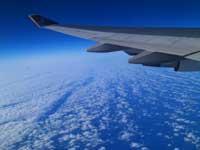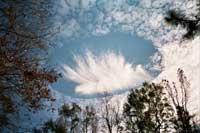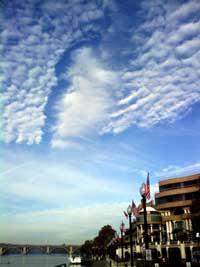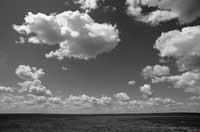Aircraft, causing rainfall?
2010/07/18 Aulestiarte Lete, Izaro - Elhuyar Zientziaren Komunikazioa

It is not new that human activity significantly influences the behavior of time. Nor are we unaware of the strange traces left by planes in the clouds. But do they affect rainfall? A group of researchers from the National Center for Atmospheric Research (NCAR) in the United States wanted to clarify this fact.
Turbohelicose planes and jet planes have explained that, as the altitude rises and falls, in certain atmospheric conditions, unconsciously, intermediate mists can form and form narrow bands of snow or rain that could descend to the ground in the form of precipitation. Through this phenomenon they leave spectacular holes or channels with irregular shape in the clouds.
Scientists claim that the “key” to the formation of these holes in the clouds would be in water drops at a temperature below 0 (-15 degrees Celsius). At a certain altitude and temperature, the mists are filled with a drop of cooled water at 5 degrees Farenheit (-15°C). Due to the purity of the water, the drops remain liquid even at 34 degrees below 0. But if the fog cools much more, the drops of water freeze, so that the water turns into ice, which can then be lowered in the form of rain or hail.

We can see several clouds as if they were pierced by a large needle. (Photo: Alan Sealls.
The movements of an airplane can cause this effect, since after the propellers and wings the air cools. As a result, NCAR members claim that the above drops can freeze and precipitate: “We have seen that any aircraft that flies in these specific conditions disturbs the clouds in a concrete way, and that this process can lead to near rainfall.”
These precipitations appear to be relatively frequent in the Pacific Northwest and Western Europe, where numerous layers of fog with supercooled water drops are observed.
"Perforated" clouds
Scientists around the world began working in the 1940s to unravel the causes of clouds with holes apparently made by a large drill.
Since then, there have been several possible causes related to aviation, such as the acoustic shock waves caused by the planes, the possible local warming of the air during the travel of the planes or the formation of ice in the wake of jet condensation.

The strange shapes and structures of mists have always surprised. (Photo: Paulo Ordoveza).
Although it was initially limited to studying the effects of jet aircraft, in the 1980s it was discovered that propeller planes could transform supercooled drops into ice crystals. And in 1990 this phenomenon began to be characterized.
However, it has been confirmed that an aircraft can cause snow from data obtained through a 2007 flight by NCAR members in the Denver area. It was detected that the flight had left an atypical echo and that the precipitation band evolved rapidly (and in a curious way).
Analyzing the data, a solid platform made up of altocumulus (medium height clouds) showed a hole and a snowfall that reached the ground. As the direction of that hole coincided with the flight routes of the commercial planes of the region. Thus, experts concluded that another plane flying in clouds could somehow form ice particles. It caused a rapid snowfall leaving behind a “perforated” channel cloud.
Published in 7K.

Gai honi buruzko eduki gehiago
Elhuyarrek garatutako teknologia





